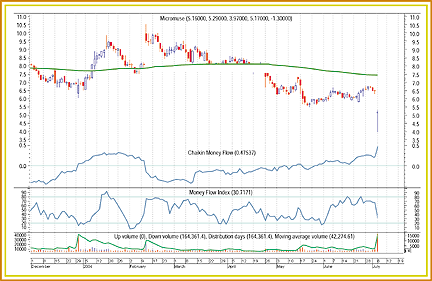A Dickens Of A Dilemma
A Tale Of Two Indicators
by Andrew Tomlinson
What do you do when two apparently similar indicators give opposite signals?
On July 6, 2004, I was feeling pretty pleased with myself. The stock market was falling and my short positions were making money for the first time in a couple of months (hey, stay on one side of the market for long enough and you're sure to be right sooner or later). One of my short positions, Micromuse (MUSE), gapped down 20% at the open on a revised outlook. When I checked the market later in the day (I trade from home, so the first day after a long weekend is an orgy of grocery shopping and ferrying the kids here and there - you get the picture - so being glued to the broker's screen is not really an option), I saw that the stock had traded down another 18% before starting to swing up again. No reason for swift action, I decided (my experience as a non-daytrader is that I lose money if I make snap judgment calls during the trading day). I chose to wait for my day's-end review before planning my next steps.
WHAT I FOUND
That evening, I opened up MetaStock and started to go through my positions. When I got to MUSE, I saw that the price had ended up pretty much where it started, showing a big initial gap down and then a spike reversal (one of those falling-window-doji-hammery-things for candlestick aficionados) on heavy volume.

Figure 1: CMF AND MFI. These indicators moved in opposite directions on a one-day spike down in MUSE.
Excerpted from an article originally published in the October 2004 issue of Technical Analysis of STOCKS & COMMODITIES magazine. All rights reserved. © Copyright 2004, Technical Analysis, Inc.
Return to October 2004 Contents